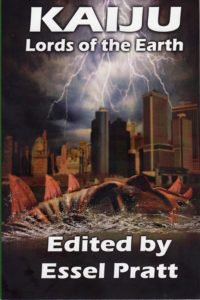Book Review: Kaiju: Lords of the Earth edited by Essel Pratt
Kaiju (“strange beast”) is primarily a subgenre of the monster movie that became codified in Japan. They’re mostly gigantic monsters that are nigh-unstoppable by conventional armaments, and run around destroying cities or fighting other giant monsters. The seeds of the story type were sown in the original King Kong movie, but it was Gojira (“Godzilla”) that codified it, and inspired most of the later examples.
This is a collection of sixteen short stories and poems on the theme of kaiju, all appearing here for the first time. The book opens with “Call of the Vailathi” by John Ledger, a poem that cautions that even when the kaiju is on your side, it is still a destructive force. …At least it has a rhyme structure, that’s good. The closing tale is “Unleashed in the East” as fracking releases a monster from the Java Sea, and two airline pilots must make a decision between saving themselves and saving the world.
I really enjoyed “The Wolf and the Rabbit” by Alice J. Black, in which a disaffected pub worker connects with another random survivor, and finds the will to do what must be done in this crisis. If the monster seems too easily dispatched, there are hints it wasn’t the only one.
Also good is “Frankentop” by Amanda M. Lyons, which is told from the perspective of an artificial intelligence that both wants to be loved, and to protect itself. Unfortunately, the latter is easier than the former. Internet references abound.
“I Awoke…Wutoomba!” by Roy C. Booth homages the Marvel monster comics of the late Fifties and early Sixties. Jack Lieiber, writer of fantastic fiction, travels to a South Seas island and runs into an assortment of stock characters, including the title monster. This one is mostly going to please Marvel fanboys who get all the in-jokes.
Most anthologies have a dud or two, but seldom to the level of “The Plastic Centipede” by R.T. Sirk. The monster itself is a cool idea, a giant centipede made of discarded mannequin parts and the vengeful spirits of a gangster’s victims. But spellchecker typos, misplaced commas, badly structured sentences and characterization by telling, not showing make this story come off like the first draft of a fanfic, rather than a professionally published story. This is clearly a failure of editing, as these banes of small press publishing should have been caught early on.
“A Day at the Racetrack” by Essel Pratt is also sub-par, as waste in a stock car racetrack’s inner pond turns animals giant-sized. Regional stereotypes are played for broad humor, as are potty jokes.
The rest are decent enough stories. Due to the very uneven quality, I would recommend this book only to kaiju fanatics or fans of a particular author for that one story.

